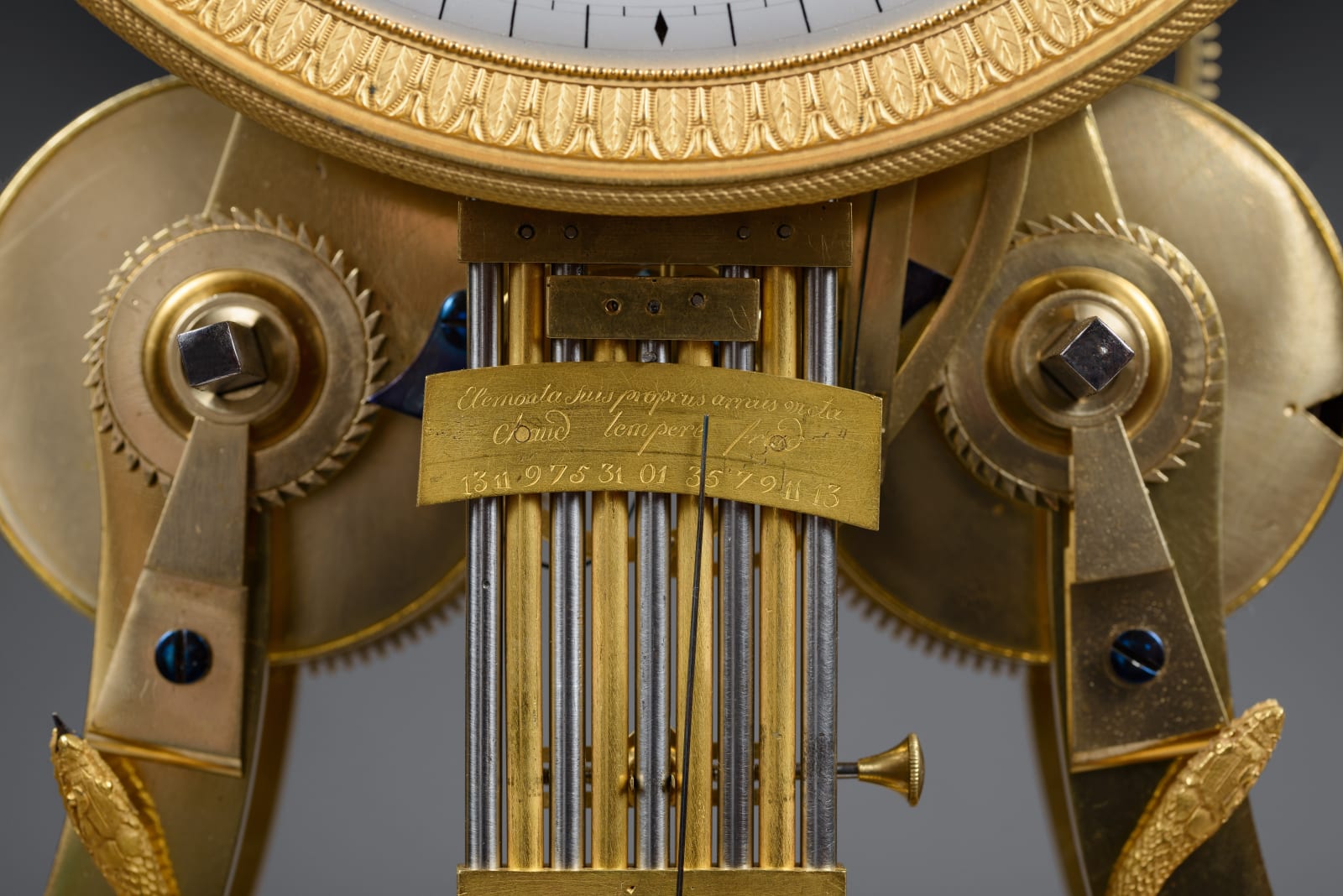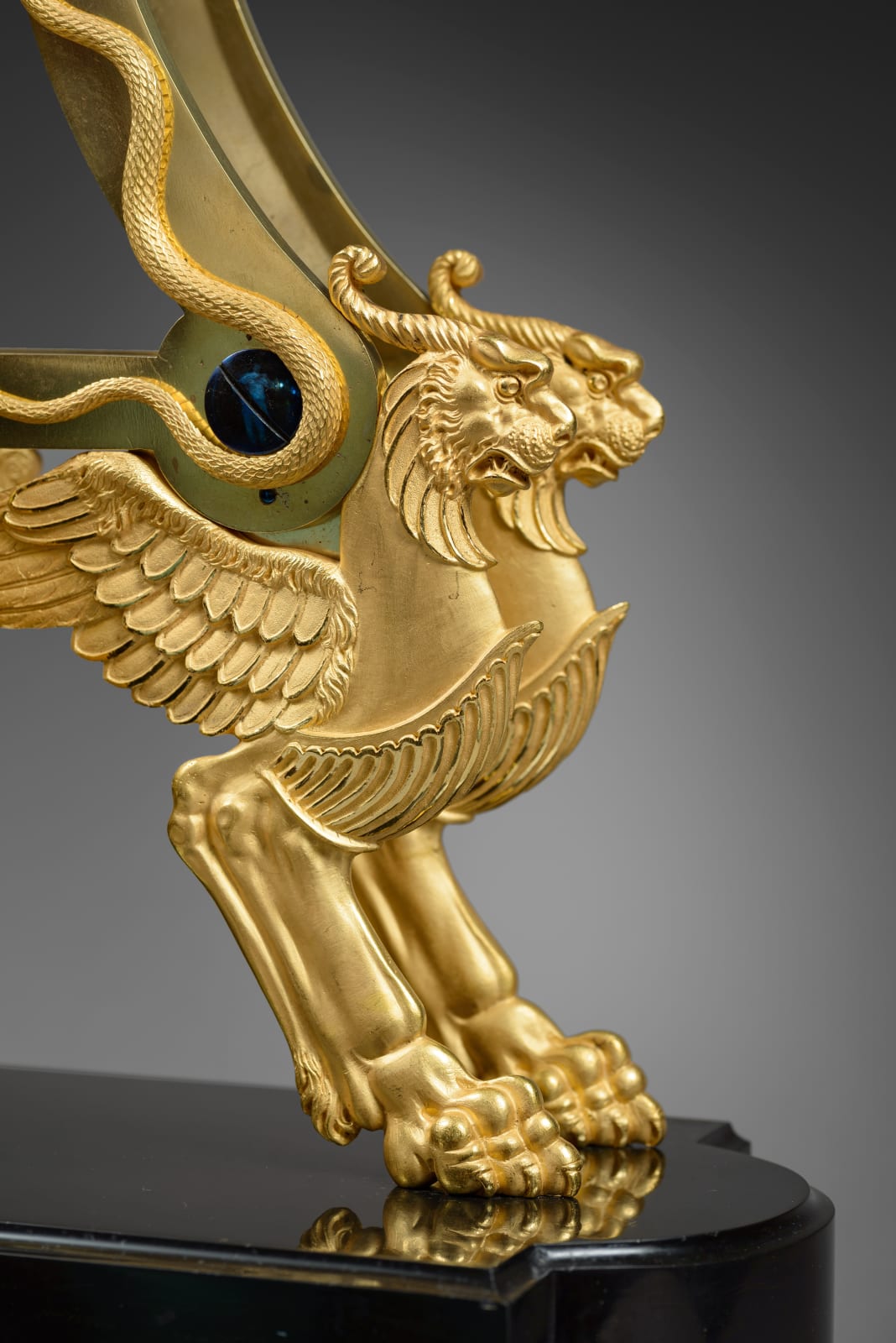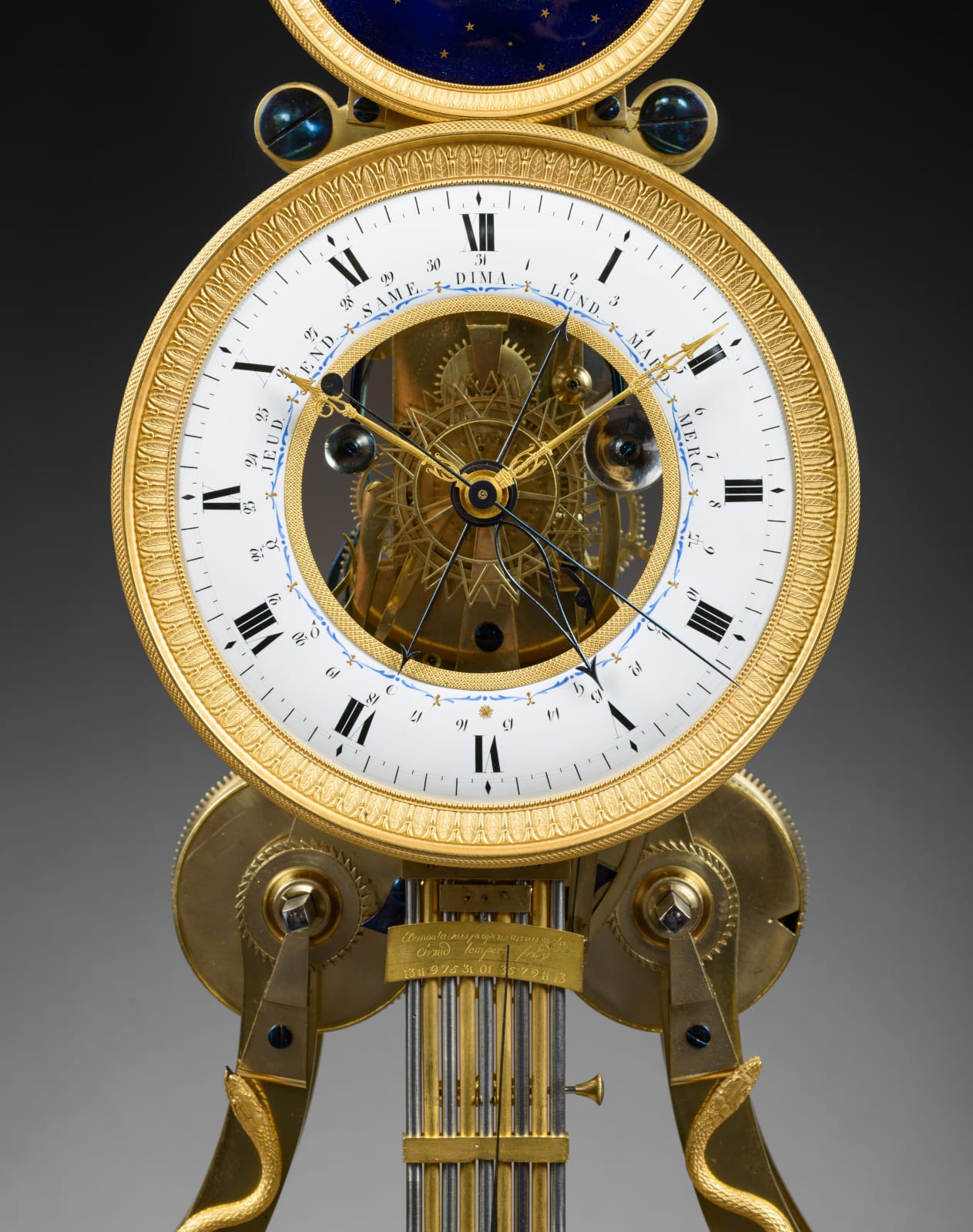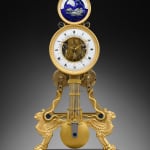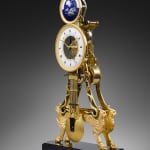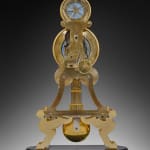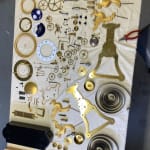Joseph Coteau (attributed to) French, 1740-1812
Further images
Literature
Tardy, “Les Plus Belles Pendules Françaises”, 1994, p. 326, illustrating a skeleton clock signed on the dial : Bosset à Paris formerly in the P. Balmès collection, with an almost identical case but without the serpents on the lower part of the inverted Y-shaped frame. And p. 327, illustrating another skeleton clock, formerly from the Refes collection, with more dials than here but likewise with an inverted Y-shaped frame supported on the backs of the same chimera. Derek Roberts, “Continental and American Skeleton Clocks”, 1989, p. 60, pl. 46a, illustrating an unsigned skeleton clock possibly by Verneuil with fine enamel work by Joseph Coteau, featuring the same inverted Y-shaped frame but without the chimera supports, a fine gilt painted white enamel main dial ring surmounted by a blue and gold star studded lunar dial with two additional subsidiary calendar dials below the main dial, again as here it has a massive gridiron pendulum which unusually is mounted on the front of the clock and again as here the whole stands upon a marble plinth. And p. 28, pl. 14, illustrating a similar type of skeleton clock by Deschamps of circa 1825, likewise with a surmounting lunar dial, a nine rod compensated pendulum and serpents winding up either side of the inverted Y-shaped frame but without the flanking chimera supports, in the Musée de Techniques, Paris.
A large and extremely fine quality Directoire/Empire gilt bronze mounted gilt brass and Belgian black marble skeleton clock of month duration with extremely beautiful enamelled dials attributed to either Joseph Coteau or Etienne Gobin, known as Dubuisson. The main white enamel dial, with a cut-out centre to reveal the elaborate skeleton work, within a fine stiff leaf and beaded gilt bronze bezel, with Roman numerals for the hours and outer half minute indications with small black diamonds for the five minute intervals, with an inner calendar ring for the 31 days of the month and within that the abbreviated names of the days of the week between 9 and 3 o’clock and then below, between 3 and 9 o’clock, the corresponding symbols of the days of the week, decorated around the inner ring with pale blue foliate scrolls interspersed by gilded motifs, with a very fine pair of pierced gilt brass hands for the hours and minutes, the former with a fleur-de-lis pointer, also with a blued steel sweep centre pointer for the half beat seconds, a pierced blued steel pointer for the days of the month and a blued steel pointer showing at one end the day of the week and at the other its corresponding symbol. The main dial surmounted by a very fine lunar dial with conforming foliate gilt bronze bezel, centred by a beautiful painted enamel dial face showing a grisaille moon against a blue and gilt star-studded sky filled with clouds and constellations, the moon with a gold pointer to indicate the 29 ½ days of the lunar month, marked within the white enamel ring.
The exceptionally fine twin-barrel movement with five massive turned pillars, four of which are brass and the other of blued steel, with pinwheel escapement, spring suspension, striking on the hour and half hours on a single bell, with a massive nine rod gridiron compensated pendulum with an adjustable blued steel pointer, mounted above with a brass temperature plaque inscribed Elementa Suis Propriis Armis Victa, with a screw at the base of the five steel and four gilt brass rods to adjust the pendulum regulation, above a large brass bob. The pendulum and bob fixed by blued steel screws which are likewise used for the finely polished inverted Y-shaped gilt brass frame which is mounted either side with a pair of gilt bronze serpents and supported on four gilt bronze outward facing winged monopodia chimera, each with lion-like heads, ram’s horns and lion paw feet, on a rectangular Belgian black marble base with rounded ends on six turned gilt bronze feet
Paris, date circa 1795-1805
Height 71 cm, width 40 cm, depth 15 cm.
A number of other similar precision skeleton clocks of this complexity are likewise unsigned while at the same time almost identical examples but with variations to the individual elements were made by such esteemed makers as Verneuil, Paratte à Paris, Schmitz à Paris, A. Jaquin Fils à Paris, as well as Lepaute, such as one from the Tronchin collection at Château de Bessinge, near Geneva. Some of the latter examples have multi-dials, which though more visually imposing, was in fact simpler for the clockmaker to construct. In contrast the present skeleton clock indicates the hours, minutes, days of the month and days of the week along with their appropriate symbols, all within the same dial ring, which required infinite ingenuity on behalf of the clockmaker. Another admirable aspect is the true nine rod compensated pendulum, complete with the temperature gauge and large bob as well as the visible star wheel for the calendar work. The latter can also be seen on a similarly constructed and unsigned skeleton clock, which Derek Roberts notes was possibly by Verneuil (illustrated, ibid.). The movement and overall arrangement also compares closely with another skeleton clock signed Verneuil her Mien which was once owned bythis gallery (illustrated in Richard Redding Antiques Ltd, 30th Anniversary”, 2008, p. 31). Interestingly the latter clock also featured on the pendulum temperature gauge the Latin inscription Elementa Suis Propriis Armis Victa, (which can loosely be translated as ‘The elements are defeated by their own weapon’); the same motto also appears on a regulator by the royal clockmaker Robert Robin (1741-99).
Given the similarity between the latter and the unsigned example also believed to be by Verneuil, it is likely that the present clock is likewise by Verneuil. Although this Parisian maker specialised in creating exceptional skeleton clocks of the highest mechanical and aesthetic quality, surprisingly little is known of Verneuil’s career; Tardy records a father and son of the same name, the elder based at 42 rue St Honoré and the younger, who sometimes signed his work Verneuil Jeune, who was based at rue du Contrat Social in 1806 and at Faubourg St-Martin in 1815. All works bearing Verneuil’s name share a close stylistic resemblance and of varying complexity, the majority include calendar work laid out in a similar manner. One particular example with a very elaborate lunar dial is further adorned with sumptuous gilt bronze mounts including Egyptian female figures, lion supports and mythological scenes on the marble base (illustrated in Roberts, op. cit. p. 56, pl. 41).
Skeleton clocks, in which the case and dial has been cut away to display the mechanism, are among some of history’s most prized scientific works of art. French skeleton clocks first began appearing during the mid eighteenth century, predominantly as a result of a wealth of the very finest Paris makers who were eager to display their technical abilities to best advantage. Such clocks were very expensive and were only intended for the elite who in turn were keen to display these works of art and thus encouraged even greater ingenuity of behalf of the clockmaker. While the evolution of the French skeleton clock occurred gradually and achieved its best period from about 1750-1830, English clockmakers did not begin producing such pieces until about 1820.
Many of the finest Parisian skeleton clocks feature elaborate enamel work of which the present clock is no exception. In fact the delicately painted lunar dial as well as the main dial ring are of the very highest standard, comparing in quality and style with the work of the two leading enamel painters at this period, namely Joseph Coteau (1740-1812) or Etienne Gobin, known as Dubuisson (b. 1731 d. after 1815). Coteau originated from Geneva but worked primarily in Paris, where he was established in rue Poupé, St. André des Arts and was received as a maître in 1778. In 1780 he was appointed peintre-émailleur du roi et de la Manufacture Royale de Sèvres Porcelain and for the next four years did piece-work there while also working independently in Paris as a flower painter, specializing in enamelling watchcases and clock dials. By 1784 he had fallen out with Sèvres and thereafter worked as an independent enamellist supplying the very finest dials, plaques and even fully decorated enamel cases to other leading Parisian clockmakers. His rival and fellow enamellist Dubuisson, who was born in Lunéville, worked firstly as a porcelain painter in his hometown as well as in Strasbourg and Chantilly. Like Coteau, he was then employed at Sèvres, where from 1756-9 he worked as a flower painter before specializing on his own account by supplying the finest enamelled watchcases and clock dials to the leading clockmakers of his day. During the 1790s Dubuisson was recorded in the rue de la Huchette and later in circa 1812 at rue de la Calandre as well as rue des Lavandières Sainte-Opportune.
JOSEPH COTEAU (1740-1812). FRENCH
Painted enamel and porcelain dials became increasingly popular during the reign of Louis XVI, reaching perfection in the hands of Joseph Coteau and Gobin Etienne (known as Dubuisson). Coteau was born in Geneva, Switzerland but is known to have practised his specialised craft in Paris. During his maturity he was established at Rue Toupee in the parish of Sant-Andre-des-Arts, where he remained until his death. At the age of 23 he produced the dial for a musical clock by Daille, horologer to Madame la Dauphine, 1763(Wallace Collection, London). Coteau attained such repute that he only ever supplied to the most eminent horologists, including Antide Janvier (1751-1835), Robert Robin (1742-1809) and Ferdinand Berthoud (1727-1807). He is also known to have decorated pieces of jewellery.
Coteau clock dials have a characteristic style, due as much to their superior quality as to their subject. His most distinct decoration consisted of delicate numerals with small garlands of flowers but more usually with signs of the zodiac, each element worked as an individual miniature. Other dials had little or no extra ornament except for the classical Louis XVI style numerals, such as his dial for the Avignon Clock, 1771 (Wallace Collection, London), with the movement by Delunesy and elaborate gilt bronze case sculptured by Louis-Simon Boizot (1743-1809) and executed by Pierre Gouthiere (1732-C.1812). At other times Coteau supplied decorative bands to accompany clock cases, such as an enamel frieze around a vase adorning one of Robert Robin's elaborate clocks, c.1780 (Wallace Collection, London). The band, painted in grisaille, depicts the seasons personified by infants playing and is interspersed by four cameo heads. A similar clock was supplied to Marie Antoinette for Chateau St. Cloud. Decorative dials and their accompanying complex quality movements fell in demand during the Revolution, however Coteau was patronised by the new government to create a number of Republican ten hour dials.
It appears that Coteau never enamelled watches or small scale pieces but specialised in larger works, which were technically more complex due to shrinkage during firing. The techniques required a high degree of skill to achieve a perfect finish. Coteau experimented with various polychromes, producing a blue that was so rare and complex that few if any of his contemporaries managed to copy. The enamel paint was applied with a brush onto a copper plate and the various colours vitrified one by one in a muffle kiln. The decoration was then enhanced by delicate gilding, which after firing resulted in a matt finish, the gilding was finally burnished to restore its metallic brightness.
Coteau dials are extremly rare, they are sometimes "secretly" inscribed on the reverse, in either pen or bruch. In addition to their scarcity and their supreme quality, his dials and enamel plaques only accompanied the most complex quality mechanisms. For these reasons his work is a tru prize and significantly enhances the value of any clock. Examples of his work can be found in a number of European museums, including Mobilier National, Musee des Arts Decoratifs, Paris; Carnavelet Museum, Dijon Museum, and in London at the Wallace Collection and Victoria and Albert Museum.
Copyright by Richard Redding , Zurich, all rights reserved.



